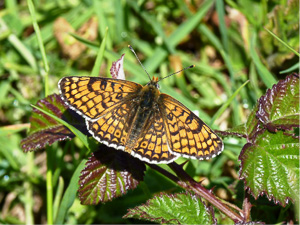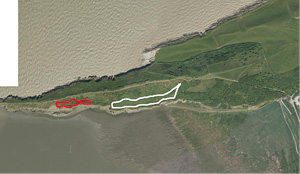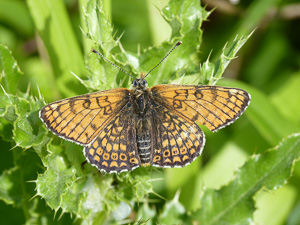Abstract: This article examines the nature conservation lessons learnt from unofficial attempts made over a thirty year period to establish the Glanville Fritillary, Melitaea cinxia, at Sand Point, a small limestone promontory on the north Somerset coast. Two colonies were established there in different eras. The first persisted from 1983 to 2000, the second from 2006 to 2013. These releases were conducted by persons unknown, who chose not to liaise with the National Trust, which owns the land, or with Butterfly Conservation or Natural England and its forerunners. Consequently, the details of these establishment attempts are not known. The two populations were, though, crudely monitored by the National Trust and Butterfly Conservation Somerset Branch, and details of habitat conditions, food plant availability and management events were recorded. Some conclusions can be derived, which may assist our understanding of the ecological requirements of this rare butterfly elsewhere, perhaps especially with regard to climate change. The ethics of clandestine butterfly introduction attempts are not discussed here.
|
National Trust Heelis Kemble Drive Swindon SN2 2NA matthew.oates@nationaltrust.org.uk |
 |
| Figure 1 - A male Glanville Fritillary, Melitaea cinxia Image © Matthew Oates |
Sand Point is not sandy. It is a Carboniferous Limestone headland which juts out into the Bristol Channel just north of Weston Super Mare, where the Mendip Hills run into the Severn estuary. It has been owned by the National Trust since 1964 and is a small part (16ha) of a 84ha Site of Special Scientific Interest (SSSI), first designated in 1952, primarily for earth heritage and botanical interests. The invertebrate fauna is not especially rich.
The promontory contains a narrow stretch of moderately steep south-facing slope. The soil covering is largely thin, though deeper pockets do occur. The slope supports an ever-changing mosaic of limestone grassland and scrub. The promontory ridge is crowned by a broken line of limestone crags, which gives way to rough grassland and bramble scrub on a narrower north-facing slope. Both flanks end in cliff faces, which are not fenced, due to cost, practical restraints and the fact that fencing would detract greatly from a strong sense of spirit of place.
 |
| Figure 2 - The Sand Point promontory, showing the two areas favoured by the Glanville Fritillary - primarily the area shown in white Image © GetMapping plc |
Sand Point is, and has always been, marginal grazing land, periodically grazed by sheep or cattle from Woodspring Farm about 1.5km to the east. The Rabbit population fluctuates greatly, and each fluctuation impacts hugely on sward height and structure.
Crucially, habitat conditions here are not stable, especially along the south-facing slope which is exposed to extremes of weather. This slope is vulnerable to drought and also prone to lush vegetation growth during wet summers.
Because Sand Point juts out into a shallow and relatively sheltered estuary it is not prone to salt spray deposition. This is an important point as salt spray deposited by storms periodically checks bramble growth along more exposed stretches of the South West coast. Here, though, only one 'bramble burn' has been recorded in recent years, after a severe storm ran up the Bristol Channel on 28th October 1996. The National Trust has been cutting bramble and scrub on Sand Point since at least the early 1980s, when extensive clearance work was carried out by Manpower Services Commission teams.
The Glanville Fritillary, Melitaea cinxia, has occurred on Sand Point in two incarnations, both of which resulted from release of larvae and / or adults by persons unknown. There is no known history of the butterfly occurring naturally, either on site or in the district. With the growing interest in butterflies, and butterfly photography, Sand Point became a place of pilgrimage for butterfly enthusiasts, saving them the expensive though glorious trip to the butterfly's heartland on the Isle of Wight.
According to my friend, the late Roger Sutton, who resided in Somerset for most of his life and knew many butterfly breeders, the initial release took place early in 1983, as a spur of the moment release of surplus breeding stock which originated from National Trust property on the Isle of Wight. The Trust was not consulted over any of these actions, and the colony only appeared on the Trust's radar when I joined as a member of staff in 1991.
Apparently, the colony fared well during the fine summers of 1983 and 1984, before numbers fell during a run of cool, wet summers. Then, the population resurged during the glorious summer of 1989. Larvae and adults were apparently 'numerous' along the entire south-facing slope during the hot spring and early summer of 1990.
I first visited Sand Point in mid-June 1991, just after a few days of wet and windy weather. I counted eight Glanville Fritillaries during an hour's walk along the lower south-facing slope. Some grazing had recently taken place, by cattle and sheep, and Rabbit numbers were low. It seemed that drought might be playing a crucial role in maintaining habitat conditions, by checking grass growth (which would otherwise suppress the butterfly's food plant, Ribwort Plantain, Plantago lanceolata), and by providing the warm microclimate conditions required by the larvae.
Between 1992 and 2000 I counted larval webs along the south-facing slope, in early spring. The maximum number of webs recorded during this period was 12. The majority of webs held 20-40 larvae, the largest 50 - fewer than most webs on the Isle of Wight (Thomas & Lewington, 2010).
| 1993 | 1994 | 1995 | 1996 | 1997 | 1998 | 1999 | 2000 | |
| Number of Webs | 3 | 10 | 12 | 3 | 12 | 10 | 3 | 0 |
| Search Time (hrs.mins) | 3 | 1.30 | 2.30 | 7.30 | 3 | 3 | 3.30 | 3 |
My diaries contain notes on the frequency and occurrence of Ribwort Plantain, grazing and habitat management activities, and vegetation conditions generally.
Searches for larval webs found that the butterfly's breeding grounds shifted periodically. This may have been because of vegetation changes, rather than due to the butterfly trying to avoid larval parasites (I never noticed any larval parasites, but they may have been present). During the period 1993 to 1999 the favoured breeding areas shifted from the lower slope immediately west of the ancient cross dyke some 200m out towards the Point, and then back to the cross dykes area (see Figure 2).
In addition, I managed to visit during each flight season in that era to conduct timed counts, often in my own time. Some visits occurred during poor weather or in windy weather - monitoring butterflies on sea cliffs is never easy on account of on-shore winds. My records show that the highest number of Glanville Fritillary adults recorded during this period was 25, on 31st May 1994. The second highest count was 16, on 20th May 1997. Later, in 2006, a butterfly transect was set up by Butterfly Conservation Somerset Branch, covering all butterfly species.
My data indicate that Sand Point held only a small colony during the period 1991-2000. It is not known whether any top-up releases took place (I think Roger Sutton would have known, and would have told me). Also, there is no evidence that the butterfly spread to form other colonies, though occasional windswept individuals were recorded further inland along the ridge, on Middle Hope. Searches there revealed no plantain-rich grassland, except in a privately-owned paddock grazed heavily by horses.
In the late 1990s the colony was affected by bad flight season weather three years running. In addition to impacting on adult activity, and perhaps on adult longevity, these adverse weather events generated strong vegetation growth, particularly of grasses. Ribwort Plantain was heavily suppressed by this growth. Plantain plants growing in warm microclimate situations were at a premium, and habitat conditions for the Glanville Fritillary consequently deteriorated.
The last butterfly of this incarnation was noted on 7th June 2000, by Roger Webber of BC Somerset and myself. During this era the Trust felt under no obligation to conserve the colony but was more than content for the population to remain so long as no special effort was necessary to perpetuate it. In fact, the Trust put a considerable amount of effort into controlling bramble and implementing cattle grazing on this difficult slope for wider nature conservation benefits. The Glanville Fritillary undoubtedly benefited from these activities. Major bramble clearance work, for example, took place during the 1993-94 winter. However, winter cutting does not control bramble, let alone eliminate it: the plant grows back vigorously.
As my diary entry for 17th March 1997 states, the south-facing slope of Sand Point proved to be 'a chameleon of a place.' The areas where the butterfly bred and flew changed considerably, and regularly.
Cattle and/or sheep were run on the Point during the autumn and early winter periods of 1991-92 to 1995-96. This reduced the dominance of coarse grasses (primarily Cocksfoot and Yorkshire Fog Grass), and also created bare ground pockets in which the food plant - a coloniser of bare ground - could grow. In 1995 the butterfly suffered poor flight season weather. Then a severe drought occurred, at a time when the Rabbit population was burgeoning.
The following summer, the vegetation on the south-facing slope consisted of: 'terrific growth of annual / biennial weeds - Sow Thistle, Musk Thistle, Common Ragwort and Soft Brome Grass in particular - and a surprising amount of Wood False-brome Grass and Cocksfoot.' (diary). Ribwort Plantain had vanished from much of the slope and was present in suitable densities only in one small area. The diary entry continues: 'Clearly, the vegetation on the south-facing slope is very dynamic and prone to great fluctuations, which does not make management at all easy'.
My forthcoming book, In Pursuit of Butterflies, a 50 year affair, sums up this incarnation: 'Rampant grass and bramble growth associated with a series of wet summers had proved too much for this small and highly isolated colony, and there was nowhere new to which it could spread. The colony had, after all, resulted from a clandestine release and to keep it the poor National Trust rangers and volunteers would have had to have gardened the slope unrealistically. Too much was being asked here.' (Ch. 29).
Early in 2006 I was approached by Roger Sutton, enquiring whether the Trust would like to have the butterfly back on Sand Point. He was apparently acting on behalf of others, who again had a surfeit of captive bred Glanville Fritillary larvae. I thanked him sincerely for asking but advised against re-introduction, as the Trust could not maintain the butterfly on a small isolated site which continually dips in and out of suitability. (Technically, it was not my decision anyway, as the National Trust has a rather convoluted process for approving wildlife releases, and extirpations, and as SSSI consent would also be required from Natural England).
Nonetheless, the butterfly reappeared, and was recorded between 2006 and 2013, sometimes in numbers. It was recorded on the Sand Point butterfly transect between 2008 and 2013 as follows:
| 2008 | 2009 | 2010 | 2011 | 2012 | 2013 | |
| Total | 16 | 28 | 16 | 33 | 66 | 6 |
During this era the adult recording periods were:
These flight seasons equate to those of the later-flying colonies on the Isle of Wight.
My own visits during this second incarnation were few and far between, as my job had changed. A visit on 17th May 2007 recorded 10 Glanville Fritillaries in 40 minutes along the lower south-facing slope, and found that the main area favoured by both the butterfly and its food plant during the 1990s had become a dense bramble thicket. Habitat conditions for the butterfly had clearly deteriorated. Two visits in March 2008 found no larvae and very little Ribwort Plantain. Nonetheless, a small number of butterflies were seen there that May.
A considerable amount of bramble and scrub clearance work was carried out by the Trust during the winters of 2009-10, 2010-11 and 2011-12. Autumn and early winter cattle grazing was reinstated at the end of 2009, and the Rabbit population dwindled.
A thorough search for larval webs on 21st March 2011 found two rather large webs, containing approximately 140 larvae. A visit on 21st May recorded seven males. That year the butterfly had been recorded on Sand Point as early as 27th April. Bramble regrowth was, though, rampant.
Despite these low figures the butterfly appeared in remarkable numbers in 2012. A visit on 4th June produced a count of 96 in an hour, the highest count recorded at Sand Point. This was remarkable given the scarcity of Ribwort Plantain and larval feeding damage, which on the Isle of Wight often remains prominent long into June. Moreover, many of the specimens flying were thinly marked, possessing very little of the black markings that characterise British populations. An example is shown in Figure 3, with even more extreme examples seen. Were they of continental origin? Had another release taken place?
 |
| Figure 3 - A lightly-marked Glanville Fritillary, Melitaea cinxia Image © Matthew Oates |
2012 brought an excessively wet summer. Butterfly populations plummeted. It was also a year of excessive grass growth. Then 2013 commenced with a cold and late spring. An hour-long search for larvae in the favoured cross dykes area found only two lone larvae. Then a visit on 29th June, right at the end of a difficult flight season, revealed two old Glanville Fritillaries. None has been seen since. The diary noted: 'The traditional breeding area is now densely covered in chest high False Oat Grass with a dense under-layer of Yorkshire Fog Grass. The same conditions dominate all deeper soil areas. The thinner soil areas, apart from the end of the Point, are dominated by dense Yorkshire Fog Grass. Conditions look great for Small Skipper. Rabbits have completely gone and we keep getting very strong grass growth seasons.' Very little Ribwort Plantain was evident.
At Sand Point, the Glanville Fritillary was dependent on a relatively small area of south-facing slope. Although its flight area periodically extended to some 3ha, only a fraction of that was suitable for breeding, and then only intermittently so. Breeding areas were prone to sudden and dramatic vegetation changes, especially as grazing was intermittent and bramble control only temporary. The butterfly was probably dependent on regular drought, to promote suitable food plant growth and suppress grass growth. In strong grass growth years the Ribwort Plantain was swamped by grasses, rendering conditions unsuitable for the egg-laying females and reducing the frequency of the warm microclimate pockets necessary for larval development (Thomas & Lewington, 2010). Also, rapid vegetation change meant that there was no guarantee that places where eggs had been laid, and where pre-hibernation larvae fed, would be suitable for the main pulse of larval development the following spring.
Strong grass growth may well be an issue for the butterfly at some sites on the Isle of Wight, particularly those off the greensands and along the lower south-facing slopes of the central chalk ridge. This raises the question of whether strong grass growth associated with wet springs and summers, and quite possibly aligned to climate change, will become a major issue in the conservation of this butterfly in the UK. This issue is not mentioned by Robin Curtis in his recent article on the future of the Glanville Fritillary in Britain (Curtis, 2014).
Whereas grazing by cattle in autumn and early winter promotes Ribwort Plantation, a 'weed' of disturbed, drought-affected or heavily grazed or trampled ground, it does not necessarily control the vigorous growth of coarse grasses stimulated by wet springs and summers. At Sand Point, cattle grazing during wet springs might have helped the Glanville Fritillary, but proved impossible to organise.
Another major problem for this butterfly at Sand Point was bramble invasion. This is a burgeoning problem in nature conservation generally, perhaps associated with climate change and / or nitrogen deposition. It is often exacerbated by scrub cutting work. A major issue here is that cutting during the winter stimulates the plant and leads to prolific regrowth. Summer cutting seems more effective, but is unfashionable due to possible impacts on nesting birds. Perhaps today's nature conservation movement simply lacks the ability to manage bramble effectively?
This article has not been concerned with the rights and wrongs of introducing butterflies to novel places. People love butterflies, and are concerned about their future. Introduction, official and otherwise, is but one manifestation of this. It would be helpful, though, if 'unofficial' releases could be reported to Butterfly Conservation, anonymously if necessary, who would then inform land managers.
It is clear that Sand Point today is not capable of supporting a self-sustaining population of Glanville Fritillary. The site is too small and dips in and out of suitability for the butterfly. Also, there is no suitable habitat within colonisation range. If the butterfly reappears on Sand Point it is unlikely to last long.
A large number of people visited Sand Point over the years to see the Glanville Fritillary, myself included. The National Trust is delighted that so many visits and memories were generated. However, it must surely be time to move on, and recognise that the Glanville Fritillary at Sand Point is now another chapter in the glorious history of butterflying.
The invaluable assistance of colleagues Adrian Woodhall and Mark Courtiour is gratefully acknowledged, and Nick Johnson of Butterfly Conservation Somerset. This article is dedicated to the memory of Roger Sutton, founder member of the British Butterfly Conservation Society (now Butterfly Conservation).